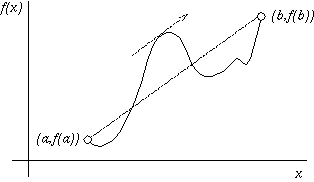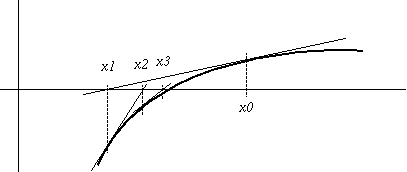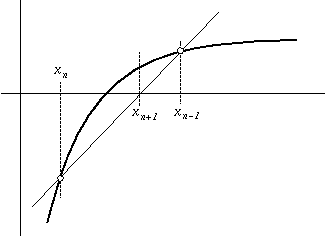Mean Value Theorem (MVT)
Theorem If f() is continuous and differentiable on an interval [a,b], then there exists some c in (a,b) such that f(b) - f(a) f'(c) = ----------- b - a Equivalently, f(b) - f(a) = f'(c) (b - a) Above, (f(b)-f(a))/(b-a) is just the slope between point (a,f(a)) and point (b,f(b)). This is the average, or `mean', slope of the function between those two points. The theorem simply says that there is a point in (a,b) for which the function *has* that mean slope.
Taylor series
Suppose we want to model a function f() near a point c. Suppose further that f() is infinitely differentiable at c and that we know f'(c), f''(c), and so on. Then we can use a polynomial function p() with the same value and derivatives to *approximate* f(). For this polynomial, we have the following constraints: p(c) = f(c) p'(c) = f'(c) p''(c) = f''(c) and so on. A polynomial that satisfies these constraints is the ``Taylor Polynomial of degree n'': 2 (n) n f''(c) (x-c) f (c) (x-c) p_n (x) = f(c) + f'(c) (x-c) + ------------- + ..... + ------------- 2! n! If n goes to infinity, we get the Taylor Series. For many functions (among them the polynomials), the Taylor Series converges to the function. That is, p_n(x) = f(x) for all x. In this course, we won't characterize the functions for which the Taylor Series converges. When approximating a function f() with the Taylor polynomial p_n() of degree n, the *residual* is r_n(x) = p(x) - f(x) Taylor's Theorem says that if the n derivatives of f() exist in an interval [a,b] that contains c, then there is *some* x_{max} in [a,b] such that (n+1) n+1 | f (c) (x_{max}-c) | n+1 r_n(x) <= ------------------ * | (x-c) | (n+1)! for all x in [a,b]. This means that the residual is bounded by some constant (a function of x_{max}) times (x-c)^{n+1}. In other words, the residual is ``of the order of (x-c)^{n+1}, written: n+1 r_n is O( (x-c) ) This gives us an idea of how fast the residual diminishes as x approaches c.Newton's method of root finding
[Readings section 3, pages 63-64] Suppose an algorithm computes successive approximations, x1, x2, x3, ..., to a root of a function f(). Consider the first-order Taylor expansion about the i^th appoximation: p(x) = f(x_i) + f'(x_i) (x - x_i) Since p(x) is approximately f(x), we set p(x) to zero and solve for the root x: f(x_i) x = x_i - ------- f'(x_i) Since p() is only an approximation to f(), this root x is only an approximation to the root of f(). So we'll use it as our next approximation, x_{n+1}. If p() is a ``good'' approximation of f(), x_{n+1} should be a better approximation to f()'s root than was x_n. This is called Newton iteration. The algorithm computes x_1 = x_0 - f(x_0) / f'(x_0) x_2 = x_1 - f(x_1) / f'(x_1) x_3 = x_2 - f(x_2) / f'(x_2) and so on. Intuitively, x_{n+1} is chosen as the point where the tangent at (x_n,f(x_n)) cuts the x axis. Theorem [page 64]
If x_n is in an interval [a,b] such that
- f(a) f(b) < 0
- f' is not zero in [a,b]
- f'' doesn't change sign in [a,b]
- f(a)/f'(a) < b-a and f(b)/f'(b) < b-a
then the Newton iteration converges to a root of f().
Newton iteration converges quadratically, provided the initial guess
x_0 is ``good enough''. To show this requires a bit of calculus,
which is presented in Section 2.2 of the Readings. In brief, if the
error in the n^{th} iteration is e_n, the Readings show that
2
e_{n+1} is proportional to e_n
Theorem [page 64]
If x_n is in an interval [a,b] such that
- f(a) f(b) < 0
- f' is not zero in [a,b]
- f'' doesn't change sign in [a,b]
- f(a)/f'(a) < b-a and f(b)/f'(b) < b-a
then the Newton iteration converges to a root of f().
Newton iteration converges quadratically, provided the initial guess
x_0 is ``good enough''. To show this requires a bit of calculus,
which is presented in Section 2.2 of the Readings. In brief, if the
error in the n^{th} iteration is e_n, the Readings show that
2
e_{n+1} is proportional to e_n
Secant method of root finding
[Readings section 3, pages 69-71] The Newton method requires the first derivative f'(), which is sometimes not available to a program. The secant method avoids this problem. To get x_{n+1} from x_n, the Newton method followed the tangent at x_n until it intersected the x axis. The secant method will approximate the tangent by drawing a line between two close points on the curve f(x). Such a line is a `secant'. Note that, as the two points get closer, the secant approaches the tangent. Thus f'(x_n) is approximated by
f(x_n) - f(x_{n-1})
f'(x_n) ~ -------------------
x_n - x_{n-1}
and the Newton iteration is modified as follows:
x_{n+1} = x_n - f(x_n) / f'(x_n)
x_n - x_{n-1}
~ x_n - f(x_n) * -------------------
f(x_n) - f(x_{n-1})
x_{n-1} f(x_n) - x_n f(x_{n-1})
= -------------------------------
f(x_n) - f(x_{n-1})
As with Newton iteration, the secant method uses for its next
approximation to the root the intersection of the secant with
the x axis.
The secant method converges a bit slower than the Newton method:
1.62
e_{n+1} is proportional to e_n
As with the Newton method, there are situations in which the
secant method will not converge to the root.
Thus f'(x_n) is approximated by
f(x_n) - f(x_{n-1})
f'(x_n) ~ -------------------
x_n - x_{n-1}
and the Newton iteration is modified as follows:
x_{n+1} = x_n - f(x_n) / f'(x_n)
x_n - x_{n-1}
~ x_n - f(x_n) * -------------------
f(x_n) - f(x_{n-1})
x_{n-1} f(x_n) - x_n f(x_{n-1})
= -------------------------------
f(x_n) - f(x_{n-1})
As with Newton iteration, the secant method uses for its next
approximation to the root the intersection of the secant with
the x axis.
The secant method converges a bit slower than the Newton method:
1.62
e_{n+1} is proportional to e_n
As with the Newton method, there are situations in which the
secant method will not converge to the root.